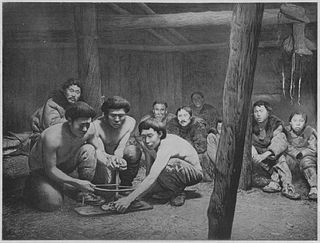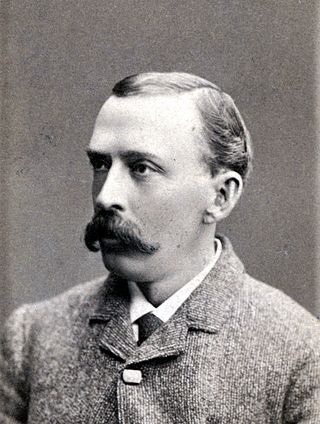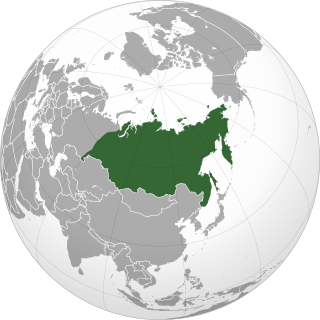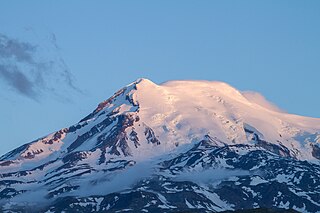
Koryaks are an Indigenous people of the Russian Far East, who live immediately north of the Kamchatka Peninsula in Kamchatka Krai and inhabit the coastlands of the Bering Sea. The cultural borders of the Koryaks include Tigilsk in the south and the Anadyr basin in the north.

Vladimir Vasilyevich Atlasov or Otlasov was a Siberian Cossack who was the first Russian to organize systematic exploration of the Kamchatka Peninsula. Atlasov Island, an uninhabited volcanic island off the southern tip of Kamchatka, and the Atlasova volcano are named after him.

The Russian Far East is a region in Northeast Asia. It is the easternmost part of Russia and the Asian continent; and is administered as a part of the Far Eastern Federal District, which is located between Lake Baikal in eastern Siberia and the Pacific Ocean. The area's largest city is Khabarovsk, followed by Vladivostok. The region shares land borders with the countries of Mongolia, China, and North Korea to its south, as well as maritime boundaries with Japan to its southeast, and with the United States along the Bering Strait to its northeast.

Atlasov Island, known in Russian as Ostrov Atlasova (Остров Атласова), or in Japanese as Araido (阿頼度島), is the northernmost island and volcano and also the highest volcano of the Kuril islands, part of the Sakhalin Oblast in Russia. The Russian name is sometimes rendered in English as Atlasova Island. Other names for the island include Uyakhuzhach, Oyakoba (Ainu) and Alaid, the name of the volcano on the island.

George Kennan was an American explorer noted for his travels in the Kamchatka and Caucasus regions of the Russian Empire. He was a cousin twice removed of the American diplomat and historian George F. Kennan, whose birthday he shared.

Johann Georg Gmelin was a German naturalist, botanist and geographer.

Yakuts or Sakha are a Turkic ethnic group native to North Siberia, primarily the Republic of Sakha in the Russian Federation, with some extending to the Amur, Magadan, Sakhalin regions, and the Taymyr and Evenk Districts of the Krasnoyarsk region. They speak the Yakut, which belongs to the Siberian branch of the Turkic languages.

The Nivkh, or Gilyak, are an Indigenous ethnic group inhabiting the northern half of Sakhalin Island and the lower Amur River and coast on the adjacent Russian mainland. Historically, they may have inhabited parts of Manchuria.

The Itelmens are an Indigenous ethnic group of the Kamchatka Peninsula in Russia. The Itelmen language is distantly related to Chukchi and Koryak, forming the Chukotko-Kamchatkan language family, but it is now virtually extinct, the vast majority of ethnic Itelmens being native speakers of Russian. A. P. Volodin has published a grammar of the Itelmen language.

The KamchatkaPeninsula is a 1,250-kilometre-long (777 mi) peninsula in the Russian Far East, with an area of about 270,000 km2 (100,000 sq mi). The Pacific Ocean and the Sea of Okhotsk make up the peninsula's eastern and western coastlines, respectively. Immediately offshore along the Pacific coast of the peninsula runs the 10,500-metre-deep (34,449 ft) Kuril–Kamchatka Trench.

Itelmen or Western Itelmen, formerly known as Western Kamchadal, is a language of the Chukotko-Kamchatkan family spoken on the western coast of the Kamchatka Peninsula. Fewer than a hundred native speakers, mostly elderly, in a few settlements in the southwest of Koryak Autonomous Okrug, remained in 1993. The 2021 Census counted 2,596 ethnic Itelmens, virtually all of whom are now monolingual in Russian. However, there are attempts to revive the language, and it is being taught in a number of schools in the region.

Stepan Petrovich Krasheninnikov was a Russian explorer of Siberia, naturalist and geographer who gave the first full description of Kamchatka in the early 18th century. He was elected to the Russian Academy of Sciences in 1745. The Krasheninnikov Volcano on Kamchatka is named in his honour.

The Russian conquest of Siberia took place during 1580–1778, when the Khanate of Sibir became a loose political structure of vassalages that were being undermined by the activities of Russian explorers. Although outnumbered, the Russians pressured the various family-based tribes into changing their loyalties and establishing distant forts from which they conducted raids. It is traditionally considered that Yermak Timofeyevich's campaign against the Siberian Khanate began in 1580. The annexation of Siberia and the Far East to Russia was resisted by local residents and took place against the backdrop of fierce battles between the Indigenous peoples of Siberia and the Russian Cossacks, who often committed atrocities against Indigenous Siberians.

Siberia is a vast region spanning the northern part of the Asian continent and forming the Asiatic portion of Russia. As a result of the Russian conquest of Siberia and of the subsequent population movements during the Soviet era (1917–1991), the modern-day demographics of Siberia is dominated by ethnic Russians (Siberiaks) and other Slavs. However, there remains a slowly increasing number of Indigenous groups, accounting for about 5% of the total Siberian population, some of which are closely genetically related to Indigenous peoples of the Americas.

The Great Northern Expedition or Second Kamchatka Expedition was one of the largest exploration enterprises in history, mapping most of the Arctic coast of Siberia and some parts of the North American coastline, greatly reducing "white areas" on maps. It was conceived by Russian Emperor Peter the Great, but implemented by Russian Empresses Anna and Elizabeth. The main organiser and leader of the expedition was Vitus Bering, who earlier had been commissioned by Peter I to lead the First Kamchatka Expedition. The Second Kamchatka Expedition lasted roughly from 1733 to 1743 and later was called the Great Northern Expedition due to the immense scale of its achievements.

Kutkh is a Raven spirit traditionally revered in various forms by various indigenous peoples of the Russian Far East. Kutkh appears in many legends: as a key figure in creation, as a fertile ancestor of mankind, as a mighty shaman and as a trickster. He is a popular subject of the animist stories of the Chukchi people and plays a central role in the mythology of the Koryaks and Itelmens of Kamchatka. Many of the stories regarding Kutkh are similar to those of the Raven among the indigenous peoples of the Pacific Northwest Coast, suggesting a long history of indirect cultural contact between Asian and North American peoples.

Fedot Alekseyevich Popov was a Russian explorer who organized the first European expedition through the Bering Strait.

Bystrinsky District is an administrative and municipal district (raion) of Kamchatka Krai, Russia, one of the eleven in the krai. It is located in the southern central part of the krai. The area of the district is 23,377 square kilometers (9,026 sq mi). Its administrative center is the rural locality of Esso. Population: 2,560 (2010 Census); 2,660 (2002 Census); 2,947 (1989 Census). The population of Esso accounts for 78.6% of the district's total population.

The Ainu in Russia are an Indigenous people of Siberia located in Sakhalin Oblast, Khabarovsk Krai and Kamchatka Krai. The Russian Ainu people, also called Kurile, Kamchatka's Kurile or Eine, can be subdivided into six groups.
The history of exploration by citizens or subjects of the Russian Federation, the Soviet Union, the Russian Empire, the Tsardom of Russia and other Russian predecessor states forms a significant part of the history of Russia as well as the history of the world. At 17,075,400 square kilometres (6,592,850 sq mi), Russia is the largest country in the world, covering more than a ninth of Earth's landmass. In the times of the Soviet Union and the Russian Empire, the country's share in the world's landmass reached 1/6. Most of these territories were first discovered by Russian explorers. Contiguous exploration in Eurasia and the building of overseas colonies in Russian America were some of the primary factors in Russian territorial expansion.


















